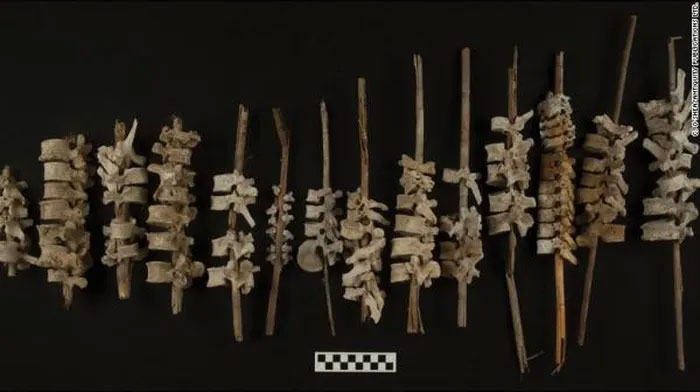Nearly 200 human vertebrae strung together with reeds have been discovered in Peru, potentially representing a unique burial practice not previously documented in the region.
An international team of researchers working in the Chincha Valley, on the southern coast of Peru, found a significant number of human spinal columns in large indigenous burial sites known as “chullpas,” which date back hundreds of years, around the time European colonizers first arrived in this South American country.
According to research published in the archaeological journal Antiquity, of the 192 vertebrae found, each corresponds to a different individual.

Each vertebra is connected by a piece of twine. (Photo CNN).
The subjects of this unique method are believed to be adult and adolescent indigenous individuals. The samples may have been created between 1450 and 1650, during the decline of the Inca civilization and the growing dominance of Europeans in the area.
Jacob L. Bongers, a specialist at the University of East Anglia in England and the lead author of the study, stated that this was a particularly chaotic period in the history of the Chincha Valley, as “disease and famine” devastated the indigenous communities.
Before the arrival of Europeans, the Chincha Valley was home to the Chincha Kingdom from 1000 to 1400, which even established an alliance with the powerful Inca Empire. However, as European colonizers flooded the area, the indigenous population dwindled from over 30,000 in 1533 to just 979 by 1583.
According to Bongers, many records indicate that tomb raiding occurred in this area during the colonial period. These raids primarily targeted gold and silver artifacts, and there were even efforts by European colonizers at the time to eradicate indigenous religious and burial practices.
Studies suggest that the linking of vertebrae may have been performed to protect the bodies from being affected by tomb raiding. Using radiocarbon dating, the research team indicated that the practice of stringing vertebrae with reeds may have taken place after the bodies had been buried for some time.
The indigenous people of the Chincha Valley placed great importance on the integrity of the body after death. Indigenous groups in the area employed various unique burial practices; for instance, the nearby Chinchorro people developed the first known artificial mummification techniques millennia before ancient Egyptians practiced this ritual.
As the mummies in the Andes region were destroyed by European colonizers, indigenous groups attempted to recover the remnants. The vertebrae found in the Chincha Valley may represent an effort to reconstruct the damaged remains of deceased individuals and restore the integrity of their bodies after tomb raiding.

















































